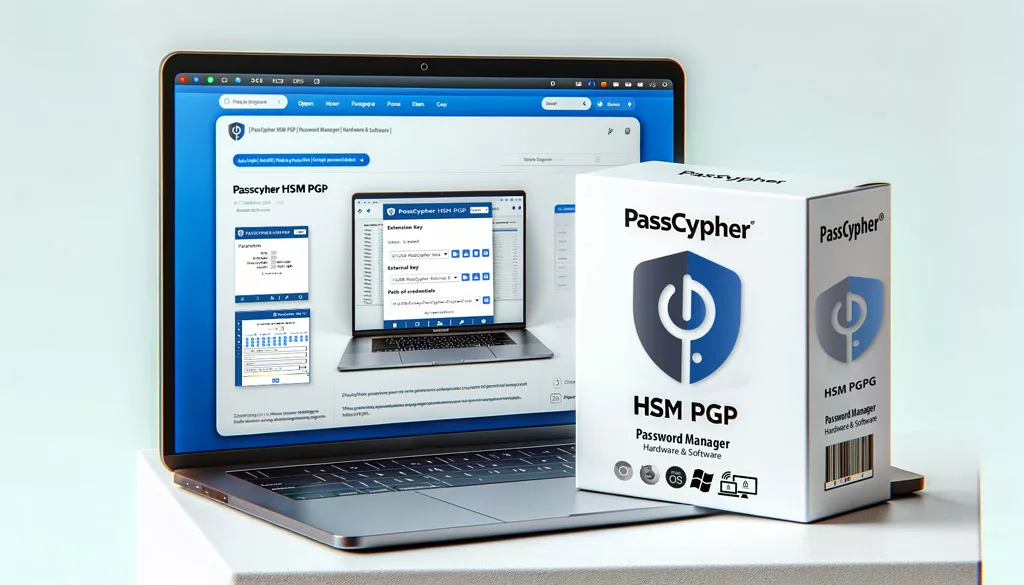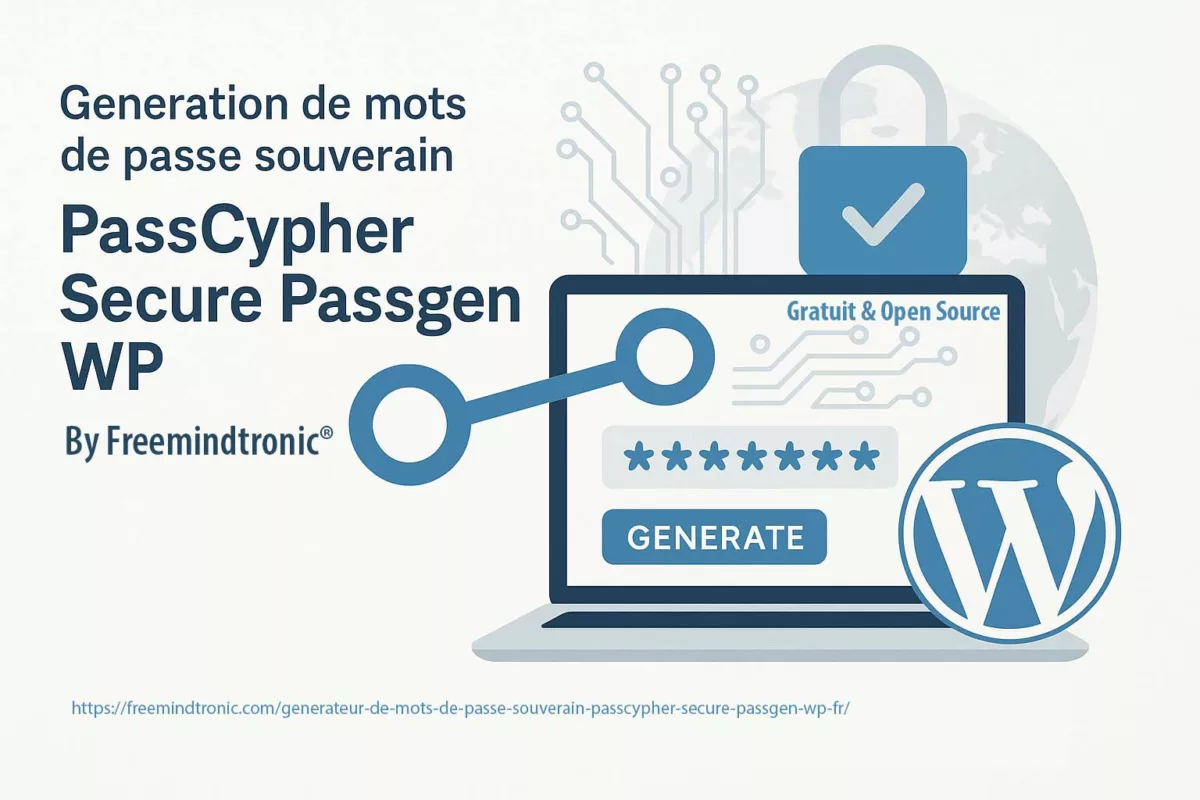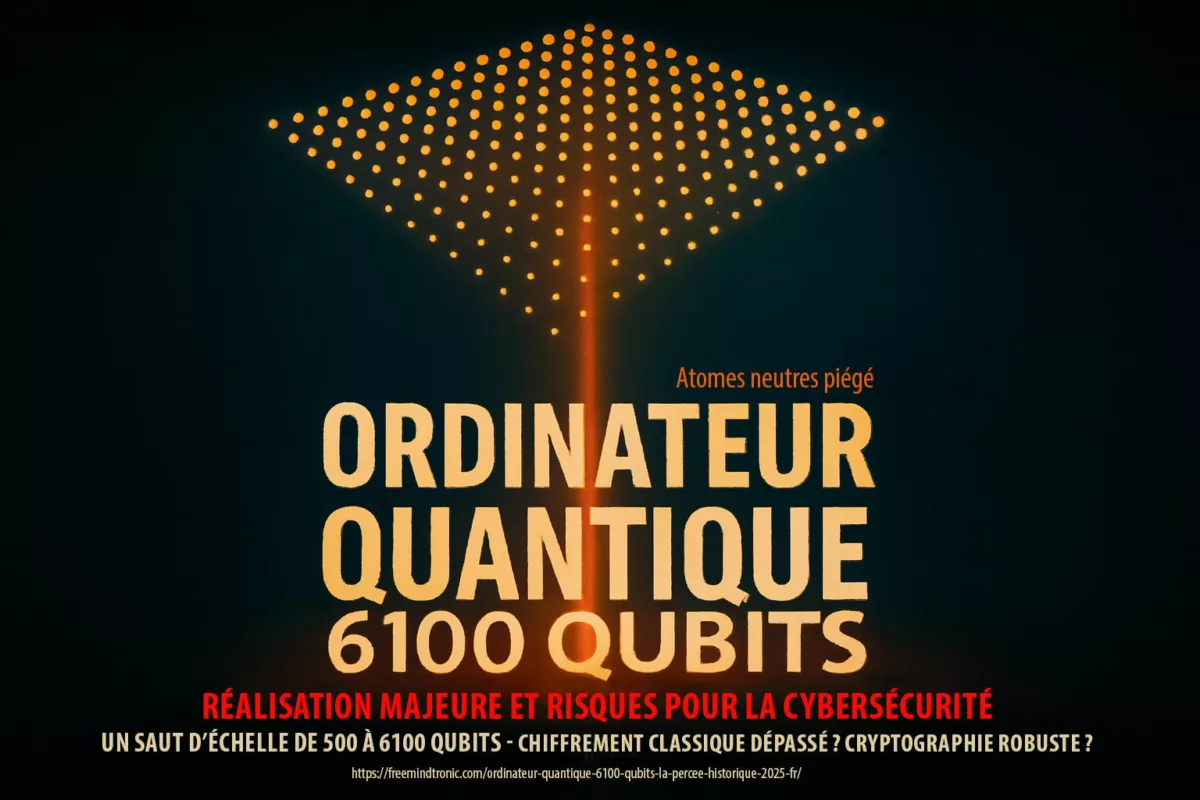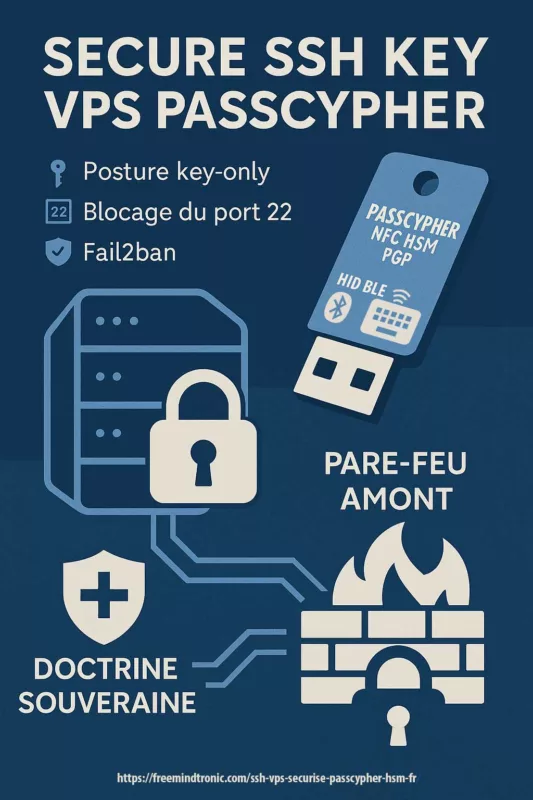Passwordless Password Manager: Secure, One-Click Simplicity to Redefine Access by Jacques Gascuel – Discover how advanced encryption, combined with innovative licensing and eco-friendly design, transforms PassCypher HSM PGP into a true game-changer in modern password management. Share your thoughts or suggestions!
PassCypher at a Glance: Revolutionizing Passwordless Password Managers
- Passwordless Authentication: Experience seamless access with a fully offline and serverless system.
- Quantum Resistance: Safeguard your data against current and future threats using AES-256 CBC encryption and patented segmented key technology.
- Eco-Friendly Design: Minimize your carbon footprint with a serverless and databaseless architecture that consumes less energy.
- Universal Compatibility: Works effortlessly with any system, requiring no updates, plugins, or complex integrations.
- Data Sovereignty: Ensure full control over your data with local storage, fully compliant with GDPR, NIS2, and other international standards.
Ideal for: Businesses, government agencies, critical industries, and any organization seeking a secure, scalable, and sustainable solution.
PassCypher HSM PGP: The Ultimate Passwordless Password Manager for 2025
This cutting-edge solution eliminates traditional passwords, replacing them with robust, AES-256 encrypted containers and segmented key authentication. Operating entirely offline without servers or databases, PassCypher provides unmatched data sovereignty and resilience against cyber threats. Ideal for organizations seeking compliance with regulations like NIS2 or GDPR, it ensures quantum-resistant security while simplifying access with one-click authentication. Whether you’re protecting enterprise systems or personal accounts, PassCypher delivers secure, eco-friendly, and future-proof password management.
PassCypher HSM PGP goes beyond traditional password management by integrating advanced cryptographic tools directly into its platform. These features include the secure creation of SSH key pairs and AES-256 encryption keys, empowering users to streamline security processes while maintaining maximum control over sensitive data. Ideal for modern organizations, PassCypher adapts to the evolving needs of professionals and teams working in dynamic environments.
Passwordless Cybersecurity Tailored for Businesses of All Sizes
PassCypher HSM PGP provides unmatched security for businesses, whether you’re a startup, an SME, or a multinational corporation:
- Small Businesses: Benefit from affordable, flexible licensing and streamlined access management.
- Large Enterprises: Ensure secure, scalable access for teams, with compliance-ready features and robust protection against ransomware.
- Critical Industries: Protect sensitive data with quantum-resistant encryption and zero-server architecture.
Hardware-Based Licensing for SMEs: PassCypher’s hardware licenses offer cost-effective, scalable solutions, enabling SMEs to enhance security without overstretching budgets. These licenses are ideal for dynamic teams requiring secure, flexible access.
👉 Learn how PassCypher transforms security for businesses of all sizes: Read more.
Why Businesses Need a Passwordless Password Manager?
- Simplify Access: Say goodbye to complex credentials and reduce login frustrations.
- Enhance Security: Protect against phishing, keyloggers, and other cyber threats.
- Boost Productivity: With one-click simplicity, employees can focus on what matters
Ready to secure your enterprise? Get started with PassCypher today!
Explore More Digital Security Insights
🔽 Discover related the other articles on cybersecurity threats, advanced solutions, and strategies to protect sensitive communications and critical systems.
The Ultimate Passwordless Password Manager
In today’s digital landscape, where cyber threats grow more sophisticated, having a robust password manager is essential. The PassCypher HSM PGP transforms access control with seamless, secure, and innovative management.
How PassCypher HSM PGP Redefines Passwordless Security
PassCypher HSM PGP introduces groundbreaking advancements that redefine what it means to be a Passwordless Password Manager. By seamlessly combining security, efficiency, and compatibility, PassCypher stands out as the most innovative solution for today’s evolving cybersecurity landscape.
Advanced Technologies Empowering Passwordless Security
- Segmented Key Technology: Unlike traditional multi-factor authentication (MFA), PassCypher uses segmented keys that eliminate reliance on vulnerable servers. This ensures enhanced data protection by distributing the key components securely.
- Complete Offline Operation: PassCypher operates entirely without servers or centralized databases. This serverless, databaseless design ensures total data sovereignty and eliminates risks associated with cloud dependency.
- Quantum-Resistant Encryption: Equipped with AES-256 CBC encryption, PassCypher is built to resist quantum computing threats, offering unparalleled security for decades to come.
- Universal Compatibility: Designed to work seamlessly with existing websites, applications, and systems, PassCypher eliminates the need for updates, plugins, or specialized integrations.
- Integrated Cryptographic Tools: Seamlessly generate secure SSH key pairs and AES-256 encryption keys, empowering professionals to maintain secure workflows with ease.
Revolutionary Auto-Login and Step-Up Authentication
PassCypher HSM PGP redefines secure access with its two-step and one-click authentication method. This cutting-edge approach combines speed, simplicity, and end-to-end security, streamlining the login process like never before.
How It Works:
PassCypher offers two streamlined methods for different security scenarios:
- Two-Step Auto-Login:
- Step 1: The user clicks the small arrow icon next to the login field. This action automatically completes and validates the username or email securely.
- Step 2: After validation, the user clicks the arrow icon next to the password field to auto-fill and validate the password, completing the login.
This method is ideal for platforms requiring both username and password for access.
- One-Click Authentication:
For services requiring only one credential (e.g., username or email), a single click on the arrow icon fills and validates the required field instantly.
Key Advantages:
- Ultra-Simple Workflow: A seamless process requiring just one or two clicks ensures effortless access without sacrificing security.
- End-to-End Security: Credentials are decrypted exclusively in volatile memory during auto-fill. The encrypted containers stored on the hardware remain untouched and fully secure.
- No Data Exposure: Credentials are never stored or transmitted in plaintext, eliminating risks of interception or compromise.
Why It Matters:
PassCypher HSM PGP revolutionizes the traditionally cumbersome two-factor authentication process by automating it with segmented key technology. All operations are conducted offline within encrypted containers, ensuring absolute protection against phishing, brute-force attacks, and other cyber threats.
Result: A streamlined, ultra-secure user experience that takes seconds to complete while safeguarding your most sensitive information.
Validate Password Strength in Real Time with Entropy Metrics
PassCypher HSM PGP includes a Shannon-based entropy gauge, enabling users to assess password strength in real time. This gauge calculates the entropy of each password, ensuring compliance with security best practices and protecting against brute-force attacks.
Why It Matters:
- Robust Passwords: The entropy gauge ensures that passwords meet the highest security standards by evaluating their randomness and complexity.
- Proven Methodology: Based on the renowned Shannon entropy formula, this feature relies on mathematically sound principles to assess and enforce password security.
- User-Friendly Design: Provides clear visual feedback, guiding users to create stronger passwords effortlessly.
This innovative feature positions PassCypher as a forward-thinking solution for password security.
Advanced Auto-Login and Step-Up Authentication
Streamlined Two-Step Authentication for Modern Needs
PassCypher HSM PGP revolutionizes security workflows by integrating Step-Up Authentication, a widely used method that adds an extra layer of protection. Here’s how it works:
- The login field is completed and validated first.
- Only after successful validation does the password field appear, allowing the user to input and validate the password separately.
With PassCypher, these steps are automated using segmented key technology:
- Auto-Fill Efficiency: Users simply click the auto-fill arrow twice—once for the login and once for the password—streamlining the process while maintaining enterprise-grade 2FA compatibility.
- Enhanced Security: This dual-step process aligns with modern authentication protocols while preserving the simplicity of passwordless workflows.
By merging ease of use with robust security, PassCypher bridges the gap between traditional 2FA and the future of passwordless authentication, offering a solution that meets the needs of both individuals and enterprises.
SSH Key Management for Developers
A New Standard in Secure Authentication and Encryption
PassCypher HSM PGP sets a new benchmark for passwordless security by integrating essential tools for secure authentication and encryption directly into its platform. These built-in capabilities simplify the creation and management of cryptographic keys, ensuring robust protection for sensitive systems and services.
SSH Key Pair Creation:
Generate password-protected SSH key pairs with an integrated real-time entropy gauge based on Shannon’s formula. This ensures the creation of strong, secure keys resistant to phishing, brute-force attacks, and unauthorized access attempts.
AES-256 Encryption Key Generation:
Easily create AES-256 CBC encryption keys in `.pem` format, secured by passwords. This feature provides an additional layer of flexibility for encrypting sensitive data and securing communications, meeting enterprise-grade security standards.
Secure SSH Key Authentication with Entropy Validation:
PassCypher enhances security by ensuring that passwords used for securing SSH key pairs meet the highest security standards. The built-in Shannon-based entropy gauge provides real-time feedback, empowering developers and IT professionals to create robust, uncrackable passwords with confidence.
Why These Features Matter:
- Simplified Security: All essential cryptographic tools are available within a single platform, eliminating the need for additional software or integrations.
- Enhanced Productivity: Streamline workflows by unifying secure key creation, passwordless access management, and advanced encryption tools in the same intuitive interface.
- Future-Ready Design: PassCypher’s built-in tools are tailored to meet the evolving needs of professionals and organizations demanding cutting-edge security solutions for tomorrow’s challenges.
Key Features of PassCypher HSM PGP as a Passwordless Password Manager
- Zero Trust and Zero-Knowledge Architecture: Data remains encrypted and inaccessible to unauthorized parties.
- Segmented Key Sharing: Enables secure collaboration without compromising data integrity.
- Eco-Friendly Design: Serverless architecture reduces energy consumption while aligning with sustainability goals.
- Universal Compatibility: Functions with existing systems, requiring no updates or prior integrations.
- Quantum-Resistant Encryption: AES-256 encryption ensures protection against current and future threats.
- Built-in Cryptographic Tools: Generate SSH key pairs and AES-256 encryption keys with ease, empowering users to manage security workflows directly within the PassCypher platform.
- Customizable Algorithms: Choose from RSA (2048, 3072, 4096), ECDSA (256, 384, 521), and ed25519 to tailor encryption strength and meet specific security requirements.
- Password Protection with Entropy Control: Ensure robust security with a real-time Shannon-based entropy gauge, allowing users to create and validate strong passwords based on proven mathematical principles.
PassCypher HSM PGP vs. FIDO2/Passkeys
While both PassCypher HSM PGP and FIDO2/Passkeys aim to eliminate traditional passwords, their architectures differ significantly:
| Feature | PassCypher HSM PGP | FIDO2/Passkeys |
|---|---|---|
| Cryptographic Key Strength | AES-256, quantum-resistant | AES-256 (non-quantum safe) |
| Server Dependence | Fully offline | Relies on cloud servers |
| Compatibility | Universal | Platform-specific |
| Data Sovereignty | Full local control | Cloud-based storage |
| Ease of Use | One-click, segmented keys | Requires integration |
PassCypher surpasses FIDO2 by offering offline operation, universal compatibility, and quantum-resistant encryption.
Visual Comparison
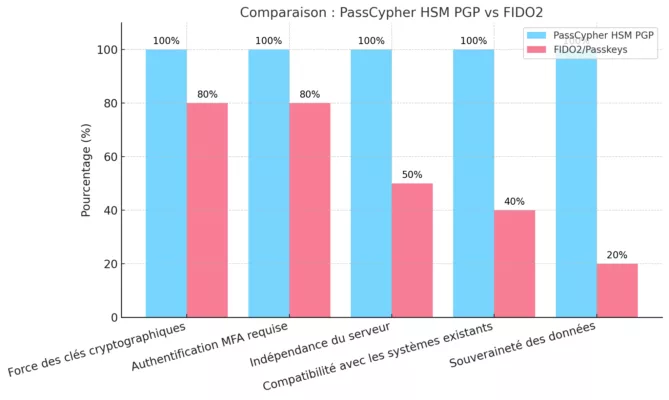
This chart highlights how PassCypher outperforms FIDO2 on critical criteria like compatibility, data sovereignty, and cryptographic strength.
Tailored Solutions for Every Industry
PassCypher adapts to the unique challenges of various industries:
- Financial Services: Prevent targeted attacks with serverless design and quantum-resistant encryption.
- Healthcare: Ensure compliance with data privacy laws such as GDPR and HIPAA.
- Technology: Protect intellectual property and sensitive data from emerging quantum threats.
- Sovereign and Regalian Needs: With its serverless and databaseless architecture, PassCypher ensures full data sovereignty, end-to-end anonymization, and compliance with national security standards for government agencies and critical infrastructure.
Why PassCypher Outperforms Traditional and FIDO2 Passwordless Solutions
PassCypher HSM PGP revolutionizes cybersecurity with its unique databaseless and serverless architecture. Unlike traditional password managers and FIDO2/Passkeys, it offers unmatched security, universal compatibility, and compliance with global regulations like GDPR and NIS2—all while maintaining eco-friendly efficiency.
| Criterion | PassCypher HSM PGP | FIDO2/Passkeys | Traditional Managers |
|---|---|---|---|
| Server Independence | Fully serverless | Requires cloud servers | Requires cloud servers |
| Data Sovereignty | Full local control | Cloud-dependent | Centralized storage |
| Quantum-Resistant Keys | AES-256 CBC + segmented keys | Limited protection | No quantum resistance |
| Ease of Use | One-click, secure logins | Integration-dependent | Manual input |
| Environmental Impact | Reduced energy use, no data centers | High due to cloud reliance | High due to cloud reliance |
| Compliance (GDPR/NIS2) | Simplified by offline design | Complex, cloud-based storage | Requires additional safeguards |
Key Advantages of PassCypher HSM PGP
-
Complete Server Independence
PassCypher operates entirely offline, eliminating reliance on cloud servers or centralized databases. This ensures total data sovereignty and enhances resilience against server outages or cyberattacks targeting cloud infrastructures.
-
Universal Compatibility
PassCypher works seamlessly with both legacy and modern systems without requiring updates, prior integrations, or ecosystem-specific dependencies. Unlike FIDO2/Passkeys, it delivers immediate functionality across diverse IT environments.
-
Enhanced Security with Quantum Resistance
- PassCypher Combines Advanced Encryption with Patented Segmented Key Technology
PassCypher HSM PGP delivers unmatched security by combining AES-256 CBC encryption with a patented segmented key system. This innovative design generates encryption keys by concatenating multiple cryptographic segments stored independently on secure hardware. As a result, it creates a robust defense mechanism that stops unauthorized access, even in the face of quantum computing advancements. - Why Quantum Computers Struggle to Break PassCypher’s Security
While quantum algorithms like Grover’s can theoretically speed up brute-force attacks, real-world limitations significantly reduce their effectiveness. Grover’s steps cannot be parallelized, and quantum hardware remains resource-intensive. Additionally, PassCypher’s segmented key design introduces extra layers of complexity. Each segment functions independently, ensuring the combined key is far more challenging to compromise than traditional AES-256 implementations.
👉 Learn more from the NIST Post-Quantum Cryptography FAQ: NIST FAQ - Patented Technology Redefines Security Standards
Unlike conventional encryption methods, PassCypher’s patented system secures encryption keys by storing them in distinct segments across multiple devices. These segments are concatenated to form a final encryption key, adding an extra level of defense that surpasses the standard AES-256 algorithm. This approach not only withstands classical attacks but also introduces a groundbreaking method to mitigate quantum threats effectively.
👉 Explore additional resources: The Quantum Resistance of AES-256 and IJARCS AES-256 Quantum Resistance - Future-Ready for Evolving Threats
PassCypher’s segmented key technology is specifically designed to address current and future cybersecurity challenges. This system strengthens enterprise-level protection while ensuring compliance with global standards like GDPR and NIS2. With a focus on scalability and adaptability, PassCypher offers peace of mind for organizations looking to safeguard their most sensitive data.
- PassCypher Combines Advanced Encryption with Patented Segmented Key Technology
-
Simplified Regulatory Compliance
The databaseless architecture of PassCypher aligns perfectly with GDPR, NIS2, and similar global regulations by storing all data locally on user devices. This approach eliminates risks tied to cloud-based breaches and simplifies regulatory audits.
-
Streamlined User Experience
With one-click authentication powered by segmented key technology, PassCypher reduces login friction and accelerates secure access, improving productivity for enterprise teams.
-
Uncompromised Sovereignty
PassCypher guarantees complete independence by operating without servers, databases, or account creation. This aligns with the highest standards for national and enterprise-level data sovereignty, making it ideal for critical industries and government entities.
-
Eco-Friendly and Energy Efficient
PassCypher’s serverless architecture reduces reliance on energy-intensive data centers, minimizing its carbon footprint. This makes it a sustainable cybersecurity solution for businesses prioritizing environmental responsibility.
-
One-Click Authentication
PassCypher simplifies secure access for employees and teams, reducing login times while ensuring robust protection.
-
Seamless Auto-Login and Auto-Fill with Two-Step Validation
PassCypher HSM PGP enhances productivity with its auto-login and auto-fill functionality, streamlining access to online accounts while maintaining robust security:
- Two-Step Validation Simplified: This feature mimics common two-factor authentication (2FA) workflows, where the user first validates their login credentials (username) and then their password. PassCypher automates this process with a two-click system, making it both fast and secure.
- Visual Assistance: A small arrow icon appears in login fields, guiding the user to complete the process effortlessly. Click once to fill in the username, and again to auto-fill and validate the password.
- Enhanced Security Against Phishing: With sandbox validation of URLs and seamless segmented key authentication, users are safeguarded against common online threats.
Key Takeaways:
- Advanced Patented Technology: PassCypher’s segmented key design creates an encryption system that is resilient to both classical and quantum threats.
- Proven Quantum Resistance: Backed by research from NIST and other credible sources, PassCypher incorporates AES-256 encryption to ensure long-term security.
- Optimized for Enterprises: The system offers a seamless, scalable solution tailored to meet the needs of businesses seeking durable and compliant cybersecurity strategies.
Comparative Table: PassCypher HSM PGP vs. FIDO2/Passkeys
| Criterion | PassCypher HSM PGP | FIDO2/Passkeys |
|---|---|---|
| Server Independence | Yes | No |
| Data Sovereignty | Fully local | Cloud-dependent |
| Compatibility | Universal, works with all systems | Requires integrations |
| Quantum-Resistant Encryption | Yes | No |
| Ease of Deployment | Immediate, no updates required | Requires ecosystem support |
Streamlined Visual Comparison

A consolidated view comparing the critical features of PassCypher HSM PGP and traditional password managers highlights its unique strengths in security, independence, and resilience.
Discover how PassCypher HSM PGP can revolutionize your cybersecurity infrastructure.
Contact us for tailored enterprise solutions today!
Technical Superiority: Segmented Encryption and Passwordless Serverless Design
Why Segmented Encryption Matters
PassCypher HSM PGP introduces two segmented keys, which are concatenated to form a final AES-256 encryption key. This method ensures:
- Elimination of weak passwords: No user-generated passwords mean brute-force attacks are obsolete.
- Mitigation of centralized vulnerabilities: Serverless design avoids database breaches.
Key Advantages:
- Quantum-Resistant Security: AES-256 protects against emerging quantum threats.
- Zero Cloud Reliance: All operations are localized, ensuring total privacy.
- One-Click Authentication: Simplifies access with segmented keys.
Zero Trust and Zero-Knowledge Architecture in a Passwordless Password Manager
PassCypher HSM PGP embraces the foundational principles of a passwordless password manager. Its zero trust and zero-knowledge architecture not only ensure that data remains encrypted but also make it inaccessible to all unauthorized parties—even the system itself. This design enforces strict verification protocols for every interaction, eliminating trust assumptions and guaranteeing data integrity.
Passwordless Authentication and Zero Trust Architecture
Passwordless authentication is more than just a trend—it’s the future of secure access. PassCypher HSM PGP integrates a Zero Trust Architecture that demands strict verification for every access attempt. By eliminating assumptions of trust, it ensures data remains encrypted and inaccessible to unauthorized parties. Transitioning to passwordless solutions not only strengthens security but also simplifies workflows, making your systems more efficient.
Centralized Security Without SSO
Traditional single sign-on systems often become points of vulnerability. PassCypher redefines centralized security by introducing segmented key sharing, which is a critical feature of its passwordless password manager. This ensures robust management while eliminating the risks of centralized failure points, providing seamless yet secure access.
Segmented Key Sharing for Passwordless Password Manager
Collaboration without compromise. With segmented key sharing, PassCypher allows authorized users to securely access encrypted data while maintaining strict compartmentalization. Unique key pairs not only ensure secure collaboration but also align perfectly with the principles of a passwordless password manager. This approach demonstrates how PassCypher HSM PGP surpasses traditional password managers by offering unparalleled security.
Segmented Key Sharing: Essential for Modern Passwordless Password Managers
Segmented key sharing isn’t just a feature—it’s the cornerstone of modern passwordless password managers. PassCypher HSM PGP uses segmented keys stored on separate devices, ensuring data remains uncompromised even in the face of advanced threats. This approach enables secure collaboration, granting access only to authorized users while maintaining strict data compartmentalization. By adopting segmented key sharing, businesses can strengthen security without sacrificing flexibility.
Hardware-Based Licensing for Enhanced Security
PassCypher’s hardware-based licensing breaks away from identity-driven models. Users can securely share a single device while maintaining unique segmented keys, offering unmatched flexibility for dynamic, multi-user environments. Moreover, this innovative approach aligns with the ethos of a passwordless password manager by providing both security and simplicity.
Advanced Container and Key Management
Most importantly, PassCypher supports virtually unlimited secure storage across USB drives, SSDs, and cloud solutions. Each container is pre-encrypted using AES-256, offering unparalleled protection for sensitive information. This flexibility cements its place as a leading passwordless password manager for organizations needing advanced data management. For those seeking a guide on implementing passwordless security solutions for small businesses, PassCypher offers an excellent starting point.
Eco-Friendly Design: A Sustainable Approach to a Passwordless Password Manager
In a world where sustainability is key, PassCypher takes the lead with its serverless architecture. By eliminating reliance on energy-intensive data centers, it not only offers an eco-friendly passwordless password manager but also prioritizes both security and environmental responsibility. The PassCypher HSM PGP is designed with sustainability in mind. With its energy-efficient serverless architecture, PassCypher champions sustainable security without compromising on protection.
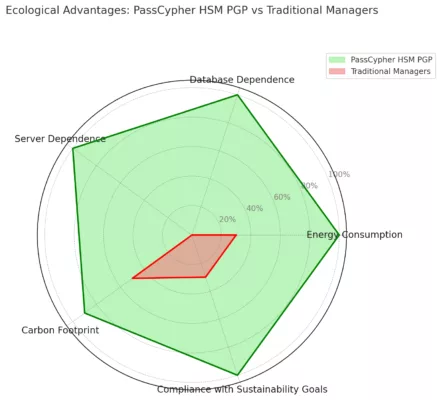
Passwordless Authentication Redefined
The foundation of PassCypher’s innovation lies in eliminating traditional passwords. By eliminating traditional credentials, it replaces passwords with AES-256 encrypted containers and segmented keys. As a premier As a leader in password-free access solutions, it guarantees password manager, it ensures:
- No Typing Risks: Keyloggers and screen captures are rendered obsolete.
- Silent, Secure Authentication: Seamless processes with no audible or visible risks.
- Instant Access: Single-click authentication without compromising security.
These features collectively redefine what it means to be a passwordless password manager, showcasing how it simplifies security while surpassing traditional methods.
Protection Against Common Threats
PassCypher neutralizes a wide range of cyber threats, including phishing, replay attacks, and keylogging. By encrypting data in containers and, at the same time, preventing plaintext password exposure, it delivers multi-layered protection. That underscores its status as a top-tier passwordless cybersecurity solution. These benefits highlight the advantages of a passwordless password manager in modern cybersecurity.
Flexible Licensing Options for the Leading Passwordless Password Manager
Furthermore, PassCypher’s innovative pricing model ties licenses to hardware, thereby providing both flexibility and anonymity. Whether for short-term use or long-term projects, its hardware-based licensing makes it the most adaptable passwordless password manager available.
Table: Sliding scale of fees
| License Type | 1 to 9 licenses | 10 to 49 licenses | 50 to 99 licenses | 100 to 249 licenses | 250 and over |
| Day (7 €/day) | 7 € | €6.50 | 6 € | €5.50 | On quote |
| Week (10 €/week) | 10 € | 9 € | €8.50 | 8 € | On quote |
| Month (15 €/month) | 15 € | €13.50 | €12.50 | 12 € | On quote |
| One Year (129 €/year) | 129 € | 119 € | 109 € | 99 € | On quote |
| Two Years (€199/2 years) | 199 € | 179 € | 169 € | 159 € | On quote |
Tailored to meet unique business requirements, custom licenses enhance the versatility of this passwordless password manager.
Eliminate Servers: The Future of Password Management
In a world where centralized data storage creates significant vulnerabilities, PassCypher HSM PGP takes a revolutionary approach by operating without servers or databases. Its databaseless and serverless architecture sets a new standard for secure and resilient cybersecurity solutions.
Key Advantages of Databaseless and Serverless Design:
- Elimination of Central Points of Failure
- Without relying on centralized databases or servers, PassCypher removes critical failure points. This ensures uninterrupted functionality even during server outages or targeted cyberattacks.
- Simplified Regulatory Compliance
- By storing all data locally on the user’s device, PassCypher makes compliance with stringent regulations like GDPR and NIS2 straightforward. No cross-border data transfer means enhanced privacy and sovereignty.
- Enhanced Resilience Against Cyber Threats
- Traditional centralized systems are frequent targets for cyberattacks, including ransomware and database breaches. PassCypher’s decentralized design eliminates these risks, safeguarding sensitive data from exploitation.
- Uncompromised User Privacy
- With no external databases or servers to access, user data remains entirely private, ensuring that even service providers cannot intercept sensitive information.
- Performance Benefits
- A databaseless design eliminates the need for database queries, delivering faster authentication and encryption processes for a seamless user experience.
Why It Matters
The serverless and databaseless architecture of PassCypher HSM PGP isn’t just an innovation; it’s a necessity in today’s cybersecurity landscape. By removing reliance on external infrastructure, PassCypher provides businesses and individuals with unparalleled security, privacy, and performance.
This serverless, databaseless architecture positions PassCypher HSM PGP as the ideal solution for individuals and enterprises seeking the best cybersecurity solutions for 2025.
Comparison with popular password managers
Before diving into the comparison, here’s an overview: The following table highlights the standout features of PassCypher HSM PGP compared to other password managers. It demonstrates how PassCypher sets a new benchmark in passwordless security.
Technical Features
| Feature | PassCypher HSM PGP | LastPass | Dashlane | 1Password | Bitwarden |
|---|---|---|---|---|---|
| Server Independence | Fully offline and serverless | Server-dependent | Server-dependent | Server-dependent | Server-dependent |
| Authentication Method | Segmented key-based MFA | Password/Biometric | Password/Biometric | Password/Biometric | Password/Biometric |
| Security Framework | AES-256 + sandbox validation | AES-256, password encryption | AES-256, password encryption | AES-256, password encryption | AES-256, password encryption |
| Quantum-Resistant Encryption | Yes | No | No | No | No |
| Database Dependence | None—databaseless architecture | Centralized database storage | Centralized database storage | Centralized database storage | Centralized database storage |
Key Takeaways
The technical superiority of PassCypher HSM PGP is clear—it operates entirely offline, ensuring full independence from servers while offering quantum-resistant encryption. With no database dependency, it guarantees unmatched security for enterprises and individuals alike.
User Experience and Flexibility
| Feature | PassCypher HSM PGP | LastPass | Dashlane | 1Password | Bitwarden |
|---|---|---|---|---|---|
| User Experience | One-click, segmented keys | Manual password input | Manual password input | Manual password input | Manual password input |
| Data Sovereignty | Full local control (no third-party ties) | Tied to servers | Tied to servers | Tied to servers | Tied to servers |
| Eco-Friendly Design | Serverless, reduced energy consumption | Requires cloud servers | Requires cloud servers | Requires cloud servers | Requires cloud servers |
| Pricing Model | Flexible, hardware-based: licenses for a day, week, month, or year | Subscription-based | Subscription-based | Subscription-based | Subscription-based |
| Protection Against Keylogging | Full (no password entry required) | Partial (relies on input security) | Partial (relies on input security) | Partial (relies on input security) | Partial (relies on input security) |
| Multi-User Flexibility | Yes—unlimited users per hardware license | No—licenses tied to individual users | No—licenses tied to individual users | No—licenses tied to individual users | No—licenses tied to individual users |
Key Takeaways
PassCypher redefines user convenience with one-click authentication and segmented key-sharing. Its hardware-based licensing model and eco-friendly design make it a leader in passwordless security solutions for businesses and individuals in 2025.
How does a databaseless architecture simplify compliance?
A databaseless architecture eliminates the risks associated with centralized storage by ensuring that all sensitive data is stored locally on the user’s device. This design minimizes the attack surface for data breaches, making it easier for businesses to comply with regulations such as GDPR and NIS2. Additionally, it simplifies audit and reporting processes by removing complex data management systems, ensuring total data sovereignty for enterprises.
Why PassCypher HSM PGP’s Pricing Model Stands Out
PassCypher’s revolutionary hardware-based pricing model is decoupled from personal or organizational identities, ensuring anonymity and flexibility, key aspects of a passwordless password manager. Users can purchase licenses by the day, week, month, or year, with no financial commitments. Unlike competitors that tie licenses to individual users, PassCypher’s licenses are bound to the hardware, allowing multiple people to securely share the same device. This innovative pricing model supports an infinite number of users, making it ideal for teams or enterprises needing scalable cybersecurity solutions. With no need for recurring subscriptions and the ability to buy short-term licenses, PassCypher offers unmatched affordability for individuals and businesses alike.
- Unlimited Users: Multiple users can securely share a single license.
- No Engagement: Flexible durations adapt to any need without long-term commitments.
- Transparent Costs: Simple, hardware-bound pricing eliminates hidden fees.
This ensures that the pricing model directly ties into the comparison, highlighting why PassCypher offers greater flexibility and affordability compared to competitors. Choose the placement based on where you’d like to emphasize the pricing model’s role in differentiating PassCypher.
Key Insights: Why PassCypher HSM PGP Stands Out in 2025
Server Independence
Unlike competitors such as LastPass or Dashlane, which rely on cloud infrastructure, PassCypher HSM PGP operates entirely offline. Its serverless architecture guarantees total data sovereignty, eliminating risks associated with server breaches, downtimes, or data leaks.
Advanced Authentication
PassCypher employs segmented key-based multi-factor authentication (MFA). This approach offers superior security compared to traditional password or biometric methods, providing robust protection for sensitive data without relying on fragile systems.
Quantum-Resistant Security
Designed for future threats, PassCypher incorporates encryption technologies resilient to quantum computing attacks—a critical feature missing in most competitors. This ensures long-term security for individuals and enterprises.
Streamlined, Secure Access for Teams and Enterprises
PassCypher redefines usability by replacing manual password input with one-click authentication using segmented keys. This approach not only reduces user friction but also eliminates keylogging risks, offering a seamless and secure experience. Balancing security and usability is critical for teams and enterprises. PassCypher achieves this balance with a seamless, one-click authentication process, simplifying secure access across the board.
Hardware-Based Licensing for SMEs
PassCypher’s flexible hardware licenses provide affordable, scalable solutions tailored for small and medium enterprises (SMEs). This ensures secure, streamlined access without breaking budgets, making it an ideal choice for organizations of all sizes.
Database-Free Design
PassCypher is a truly databaseless solution, storing all user data locally. In contrast, traditional password managers like 1Password and Bitwarden rely on centralized databases, which are vulnerable to breaches. With PassCypher, there are no central points of failure, ensuring enhanced privacy and security.
Eco-Friendly and Sustainable
With its serverless architecture, PassCypher consumes significantly less energy compared to cloud-based solutions that require constant server operations. This makes it a sustainable choice aligned with modern environmental goals.
Unparalleled Sovereignty
With no reliance on servers or databases, PassCypher ensures complete independence. This is particularly advantageous for businesses and governments prioritizing data sovereignty, regulatory compliance, and national security. The end-to-end anonymity it offers makes it uniquely positioned for critical industries and sensitive operations.
End-to-End Anonymity
PassCypher delivers complete anonymity by eliminating the need for user accounts, personal information, or master passwords. This approach ensures unparalleled privacy and prevents any third-party access to sensitive data, setting a new standard in the industry.
Supports NIS2 Compliance for Essential and Important Entities
The NIS2 Directive sets stringent cybersecurity requirements for essential and important entities across the European Union, including sectors like finance, healthcare, energy, and telecommunications. PassCypher HSM PGP addresses these needs with:
- Robust Encryption: AES-256 encryption and segmented key authentication meet the directive’s requirements for strong cybersecurity measures.
- Serverless Design: Its fully offline architecture eliminates vulnerabilities associated with centralized servers and databases, ensuring resilience against cyber threats.
- Data Sovereignty: By operating entirely locally, PassCypher simplifies compliance with NIS2’s focus on securing sensitive data.
- Simplified Risk Management: PassCypher reduces the complexity of incident response and regulatory reporting through its zero-trust architecture and lack of centralized failure points.
For organizations striving to meet NIS2 compliance, PassCypher HSM PGP offers a future-ready, secure solution that aligns with the directive’s key objectives.
The Impact of PassCypher’s Unique Features on Modern Cybersecurity
PassCypher HSM PGP’s unique combination of serverless, database-free design, quantum-resistant encryption, and end-to-end anonymity ensures that it stands apart from traditional password managers. Whether you’re a business seeking the best passwordless solutions for enterprises or an individual prioritizing secure authentication without relying on centralized databases, PassCypher offers an unmatched cybersecurity solution.
This updated section highlights databaseless architecture, server independence, and the innovative features that make PassCypher the most advanced passwordless password manager for 2025.
With cybersecurity evolving rapidly, every feature of PassCypher is designed to address the challenges of today’s digital landscape. Let’s explore how these innovations transform modern cybersecurity for businesses and individuals alike.
Future-Proof Quantum-Resistant Encryption
PassCypher redefines security by integrating quantum-resistant AES-256 CBC encryption with its patented segmented key technology. This innovative combination delivers unparalleled protection against current and emerging threats, including quantum computing. Designed for scalability and durability, PassCypher ensures your data remains secure for decades, setting a new standard for passwordless password managers in 2024 and beyond.
Preparing for the Quantum Computing Era
PassCypher’s advanced encryption and segmented key approach provide a robust defense against quantum threats. While algorithms like Grover’s aim to expedite brute-force attacks, real-world limitations—such as the inability to parallelize steps effectively—significantly reduce their impact. PassCypher takes this a step further by introducing additional layers of complexity with segmented key design, making unauthorized access exponentially more challenging.
Learn More About Quantum-Resistant Encryption
Explore detailed insights on protecting data against quantum threats:
- 👉 Quantum Computing Risks to AES and RSA Encryption
- 👉 How to Create and Protect Quantum-Resistant Passwords
Why Passwordless Password Managers Are the Future of Cybersecurity
Passwordless password managers are the future of cybersecurity, and PassCypher HSM PGP is leading the way. By eliminating traditional credentials, it neutralizes vulnerabilities like phishing and brute-force attacks. Moreover, its quantum-resistant encryption ensures long-term protection against emerging threats. With PassCypher, organizations can confidently transition to a security model that anticipates and mitigates future risks, providing unparalleled peace of mind.
Future-Proof Security Against Quantum Computing Threats
As quantum computing evolves, traditional encryption faces new risks. PassCypher addresses these challenges with innovative, quantum-resistant technologies.
👉 Understand the impact of quantum computing on traditional encryption.
👉 Discover best practices for quantum-resistant password creation.
Resilience Against Ransomware Attacks
Ransomware attacks pose a critical threat to modern businesses. PassCypher ensures data security through AES-256 CBC encrypted containers and its serverless architecture, making sensitive information inaccessible to attackers.
- Encrypted Containers: Protect critical data from unauthorized encryption or tampering.
- Serverless Architecture: Eliminates centralized vulnerabilities, ensuring continuity even during attacks.
👉 Learn more about resilience against ransomware.
Passwordless Security Redefined with PassCypher
PassCypher HSM PGP fully embraces passwordless principles by replacing traditional passwords with AES-256 encrypted containers and segmented keys. This innovative approach eliminates the need for users to manage passwords while enhancing security and maintaining simplicity.
PassCypher HSM PGP vs. FIDO2/Passkeys: Key Compatibility Advantages
PassCypher HSM PGP stands out by offering universal compatibility with existing systems, requiring no prior integration or updates, unlike FIDO2/Passkeys. This flexibility ensures seamless deployment across all environments without ecosystem-specific constraints.
Distinct Advantages:
- Immediate Functionality: No dependency on website or application updates.
- Universal Compatibility: Works with legacy and modern systems alike.
Unmatched Data Sovereignty
PassCypher HSM PGP ensures complete control over cryptographic keys and user data through its offline, serverless design. Unlike FIDO2/Passkeys, which often rely on cloud storage, PassCypher eliminates third-party dependencies, simplifying compliance with regulations like GDPR.
Core Benefits:
- Local Key Storage: Cryptographic keys are stored entirely on the user’s device.
- Regulatory Compliance: No data crosses borders, ensuring privacy and sovereignty.
Enhanced User Experience
PassCypher combines strong security with ease of use:
- One-Click Authentication: Simplifies secure access for users and teams.
- CAPTCHA v3 Compatibility: Ensures smooth workflows without unnecessary interruptions.
Comparative Table: PassCypher vs. FIDO2
| Criterion | FIDO2 Passkeys | PassCypher HSM PGP |
|---|---|---|
| Server Independence | No | Yes |
| Data Sovereignty | Cloud-dependent | Fully local |
| Compatibility | Requires integration | Immediate and universal |
By combining segmented key technology with complete offline functionality, PassCypher HSM PGP surpasses traditional passwordless solutions, providing an unmatched blend of security, compatibility, and sovereignty.
In a world where traditional passwords are increasingly vulnerable, PassCypher introduces a groundbreaking approach to redefine access control. Discover how this passwordless solution sets new benchmarks in secure authentication.
How Does PassCypher HSM PGP, the Most Innovative Passwordless Manager 2025, Work
Understanding how PassCypher HSM PGP operates highlights its status as a premier passwordless password manager. The system leverages segmented keys stored securely on hardware, enabling seamless authentication and encryption. By eliminating the need for traditional credentials, users experience a simplified yet secure process. Explore how PassCypher HSM PGP works to see its innovative technology in action.
Explore how PassCypher can revolutionize your business. Contact us for enterprise solutions.
Why It Matters
PassCypher HSM PGP isn’t just another product; it’s a transformative passwordless password manager. By combining advanced encryption, sustainability, and user-centric innovation, it sets a new standard for data security. Experience the future of cybersecurity today.
What is PassCypher HSM PGP, and why is it a Passwordless Password Manager?
In addition to replacing traditional passwords, PassCypher HSM PGP introduces advanced segmented key authentication and AES-256 encrypted containers. Unlike traditional solutions, it operates with a databaseless and serverless design, ensuring robust security and complete data sovereignty.
How does PassCypher HSM PGP outperform traditional password managers?
PassCypher HSM PGP surpasses traditional password managers in several ways:
- It eliminates password vulnerabilities by replacing them with segmented key authentication.
- Moreover, it operates entirely offline, which ensures total data sovereignty.
- It simplifies access with single-click authentication.
In comparison to popular password managers, PassCypher provides unmatched security and independence.
Why is segmented key technology crucial for modern cybersecurity?
Segmented key technology divides encryption keys into parts stored on separate devices. Consequently, this prevents a single point of failure and enhances data protection. This innovation ensures PassCypher HSM PGP stands out as a leader among passwordless solutions.
How can small businesses implement a passwordless password manager cybersecurity solution?
To integrate PassCypher HSM PGP:
- Transition from conventional password managers to segmented key-based systems.
- Train your team on how to use hardware-based authentication.
- Gradually replace outdated methods with PassCypher’s eco-friendly and scalable solutions.
This practical guide simplifies how to implement a passwordless password manager effectively.
For a detailed guide, explore our Practical Guide to Passwordless Security Solutions for Small Businesses.
What are the key advantages of a passwordless password manager?
A passwordless password manager like PassCypher HSM PGP offers:
- Enhanced protection against phishing and keylogging.
- Streamlined user experiences with single-click access.
- Full independence from cloud servers.
- Scalability for small businesses and enterprises alike.
These features make it one of the most advanced cybersecurity solutions for 2025.
How does PassCypher protect against common cyber threats?
PassCypher protects against:
- Phishing attacks: By validating URLs within a secure sandbox.
- Replay attacks: Through encrypted segmented key sharing.
- Keylogging risks: By removing the need for typed passwords.
Its robust defense mechanisms solidify PassCypher’s position as the leading passwordless solution for enterprises.
What licensing options does PassCypher offer?
PassCypher provides flexible plans, including:
- Ephemeral Licenses: Day (7 €), Week (10 €), Month (15 €).
- Annual Licenses: One Year (129 €), Two Years (199 €).
- Custom Licenses: Designed for unique business needs.
This flexibility ensures businesses can scale their passwordless password manager effortlessly.
What makes PassCypher eco-friendly?
PassCypher’s serverless design reduces reliance on energy-intensive data centers. By using local hardware and segmented keys, it minimizes its environmental impact, combining sustainability with advanced passwordless authentication methods.
How does a databaseless architecture simplify compliance?
A databaseless architecture eliminates the risks associated with centralized storage by ensuring that all sensitive data is stored locally on the user’s device. This design minimizes the attack surface for data breaches, making it easier for businesses to comply with regulations such as GDPR and NIS2. Additionally, it simplifies audit and reporting processes by removing complex data management systems, ensuring total data sovereignty for enterprises.
Which industries benefit most from passwordless cybersecurity?
Industries such as finance, healthcare, technology, and government gain the most from PassCypher’s passwordless framework. Its advanced segmented key technology ensures optimal security, even for enterprises handling sensitive data.
How does PassCypher prepare for quantum computing threats?
PassCypher uses AES-256 CBC encryption and segmented keys to remain resilient against quantum computing attacks. This forward-thinking approach makes it one of the most advanced cybersecurity solutions to protect enterprise data in the future.
Why should businesses adopt Passwordless Password Manager in 2025?
- Robust defenses against emerging threats.
- Simplified user workflows, improving productivity.
- Future-proof encryption technologies for long-term security.
PassCypher demonstrates why it is the best choice for businesses aiming to transition to secure authentication solutions.
What is PassCypher HSM PGP, and why is its database-free design significant?
PassCypher HSM PGP is a passwordless password manager that operates without relying on any databases. By storing all information locally, it ensures maximum privacy, security, and performance.
How does PassCypher’s database-free design protect against cyber threats?
With no centralized database to target, PassCypher eliminates vulnerabilities associated with server breaches, ensuring unmatched resilience against cyberattacks.
What are the benefits of a databaseless and serverless architecture?
PassCypher’s zero-database and no-server architecture ensures:
- No central points of failure: Resilience against server outages and database breaches.
- Enhanced compliance: Full alignment with regulations like GDPR, thanks to its privacy-first design.
- Improved performance: Faster, localized encryption and authentication processes.
- Eco-friendly security: Minimal energy consumption without reliance on cloud-based infrastructures.
Why is PassCypher’s databaseless architecture the future of cybersecurity?
With cyber threats targeting centralized systems more aggressively than ever, the databaseless architecture of PassCypher ensures:
- Greater privacy: No data leaves the device, reducing exposure to third-party breaches.
- Higher adaptability: Perfect for industries like healthcare, finance, and government that demand stringent security.
- Long-term scalability: Operates without costly server infrastructure or database maintenance.
What are the benefits of a passwordless manager for small businesses
A passwordless manager like PassCypher HSM PGP helps small businesses improve productivity, enhance security, and reduce the risk of cyberattacks. It offers cost-effective, flexible licensing and a user-friendly experience tailored for teams of any size.
How does PassCypher protect against phishing and ransomware attacks?
PassCypher uses sandbox URL validation to block phishing attempts and prevents ransomware by encrypting data in secure containers. Its databaseless architecture ensures no centralized vulnerabilities can be exploited.
Is PassCypher compatible with GDPR and FIDO2 standards?
Yes, PassCypher is fully compliant with GDPR, as it ensures complete data sovereignty and user privacy. While it offers alternatives to FIDO2 passkeys, its offline architecture provides a more secure and independent solution.
What industries can benefit most from PassCypher?
Industries such as healthcare, finance, government, and technology can greatly benefit from PassCypher’s robust passwordless solutions. More importantly, its unparalleled security for sensitive data makes it a preferred choice for organizations with high compliance and privacy standards.”
How does PassCypher address common business challenges?
To begin with, PassCypher simplifies access management, which helps businesses save time and resources. Additionally, it reduces operational costs and strengthens cybersecurity against emerging threats. This combination of benefits makes it an ideal solution for both small businesses and large enterprises looking to modernize their security frameworks.
What sets PassCypher apart from FIDO2 solutions?
First and foremost, unlike FIDO2-based systems that rely heavily on cloud infrastructure, PassCypher operates entirely offline. As a result, it ensures full data sovereignty, enhanced privacy, and robust protection against centralized breaches, providing an unmatched level of independence for users.
Can PassCypher HSM PGP be integrated with existing systems?
Yes, PassCypher seamlessly integrates with existing IT infrastructures. Furthermore, this integration enables businesses to enhance their cybersecurity without disrupting workflows, ensuring a smooth transition to passwordless authentication solutions.
What is the environmental impact of PassCypher?
When it comes to sustainability, PassCypher’s serverless architecture significantly reduces energy consumption. This not only minimizes environmental impact but also provides a sustainable cybersecurity solution for environmentally conscious organizations seeking to balance security and eco-friendliness.
Why is PassCypher HSM PGP completely independent of servers and databases?
PassCypher HSM PGP is built on a serverless and database-free architecture to ensure:
- Maximum Security: By eliminating centralized servers and databases, PassCypher removes critical failure points often targeted by cyberattacks like data breaches.
- Total Privacy: All data is stored locally on the user’s device, ensuring complete data sovereignty and strict compliance with privacy regulations like GDPR.
- Increased Resilience: Unlike server-dependent solutions, PassCypher continues to operate seamlessly, even during network outages or cloud service disruptions.
- Eco-Friendly Design: The absence of server infrastructure significantly reduces energy consumption, minimizing its environmental footprint.
By embracing these principles, PassCypher redefines password and access management with a solution that is resilient, private, and sustainable.
How does PassCypher help with ISO27001 or GDPR compliance?
PassCypher HSM PGP is designed with a databaseless and serverless architecture, ensuring total data sovereignty. All information is stored locally on the user’s device, eliminating risks associated with centralized databases.
- ISO27001: PassCypher meets strict information security requirements through its segmented key authentication model and AES-256 encryption.
- GDPR: By removing the need for servers or databases, PassCypher guarantees data privacy and minimizes the risk of personal data breaches.
Can it be used with mobile devices?
PassCypher HSM PGP is not directly compatible with mobile devices. However, it works seamlessly with PassCypher NFC HSM (Lite or Master), which is compatible with Android phones.
With the Freemindtronic Android application integrating PassCypher, a pairing system allows hybrid use:
- On mobile with PassCypher NFC HSM: Manage credentials and passwords directly on an Android device.
- Paired with PassCypher HSM PGP: A QR code system enables transferring credentials and passwords between the two systems without transferring entire containers, ensuring the security of sensitive data.
Learn more about:
How does PassCypher HSM PGP align with the NIS2 Directive?
PassCypher HSM PGP’s serverless and databaseless architecture significantly reduces energy consumption compared to cloud-reliant competitors. By operating entirely offline and avoiding energy-intensive data centers, it aligns with corporate sustainability goals, offering a cybersecurity solution that combines robust protection with environmental responsibility.
How does PassCypher HSM PGP align with the NIS2 Directive?
PassCypher HSM PGP replaces traditional passwords with randomly generated credentials that are at least equivalent in security to FIDO/Passkey standards. These high-strength passwords are stored within an AES-256 CBC-encrypted container and accessed via a segmented key pair, ensuring top-tier security. Users benefit from one-click authentication, where the system retrieves and applies these credentials automatically, enabling secure logins in under one second. This streamlined process enhances both security and user experience, making it ideal for enterprise environments.
